
By Jill Heinerth, Underwater Videographer - www.IntoThePlanet.com
June 26, 2011
Today was the last ocean dive of our project. I always get the “last day worries” towards the end of a project. I realize that this is the point when people either get tired and complacent or comfortable and complacent, in either case, complacency kills.
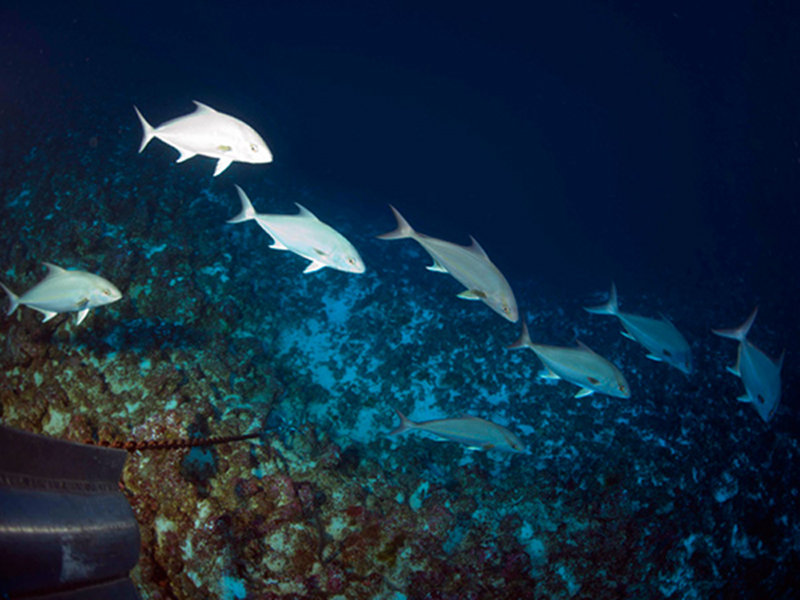
School of Almaco Jack greeting divers at the top of the Challenger Seamount wall at a depth of 200 ft. Image courtesy of Jill Heinerth, Bermuda Deep Water Caves 2011 Exploration, NOAA-OER. Download larger version (jpg, 4.0 MB).
Dr. Tom Iliffe and I were tasked with returning to Challenger Seamount to attempt the deepest dive of the project. The seas looked reasonable close to Bermuda, but there were concerns that recent winds would generate heavy swells. Our tide schedule was not cooperating well either and we expected current.
A few hiccups in the morning left us with a rather late departure. We were getting close to cut off time when it might be too late to complete a dive within safe daylight hours, but at the last moment, everything fell together. Tom napped on the way out, but I was mentally rehearsing my dive. I had gone to bed early and felt well rested. I like to mentally rehearse potential risks and positive solutions to emergencies. It is a pre-visualization exercise that helps me focus before a big dive. It starts the night before, when I like to be alone with my thoughts and turn down the mental and physical distractions of life.
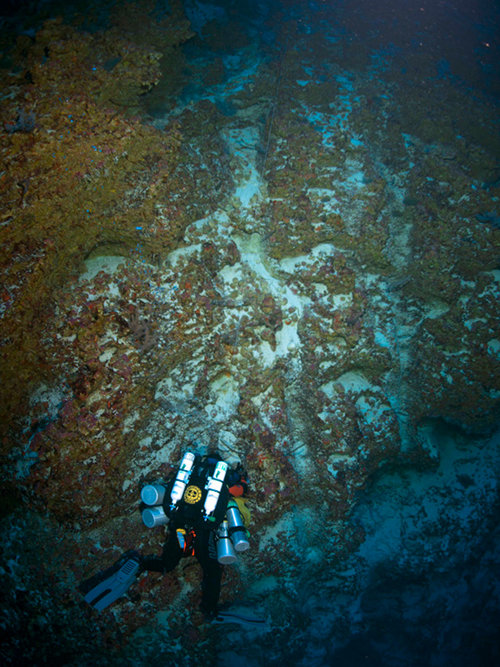
Tom starting to reel from 448 ft depth. Image courtesy of Jill Heinerth, Bermuda Deep Water Caves 2011 Exploration, NOAA-OER. Download larger version (jpg, 5.6 MB).
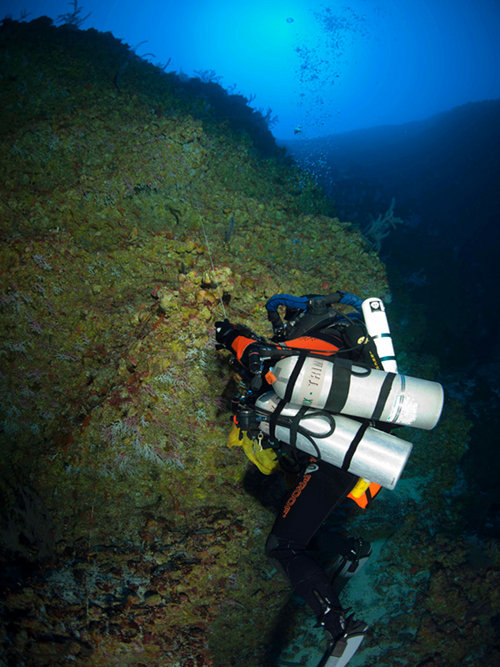
Tom (still) reeling back up to anchor line at 200 foot depth. Image courtesy of Jill Heinerth, Bermuda Deep Water Caves 2011 Exploration, NOAA-OER. Download larger version (jpg, 4.9 MB).
Tom and I slipped into the water and were immediately buzzed by Almaco Jacks and huge schools of smaller fish. Nearby fishermen seemed to be having a good day on the bank and were even chumming for action. I was not completely happy that they were dropping blood and guts into the water in which I would decompress for hours.
We dropped our weighted line on top of the bank, landing it in 215 feet of water on the peak of the ancient volcanic mount. After doing a short bubble check at 15 feet, Tom and I raced for the bottom as fast as our free fall would take us. Tom tied a reel into the weighted chain and we set off on the next leg of descent. We swam down a trough-like valley that was cut into the sheer side of the seamount, doubling our depth and stopping at 448 feet. We were looking down on what appeared to be the entrance of a cave just beyond our grasp, perhaps another 25 feet deeper. We turned to each other with a silent nod and realized that we had been fortunate to have a safe and productive project and turned back towards the surface.
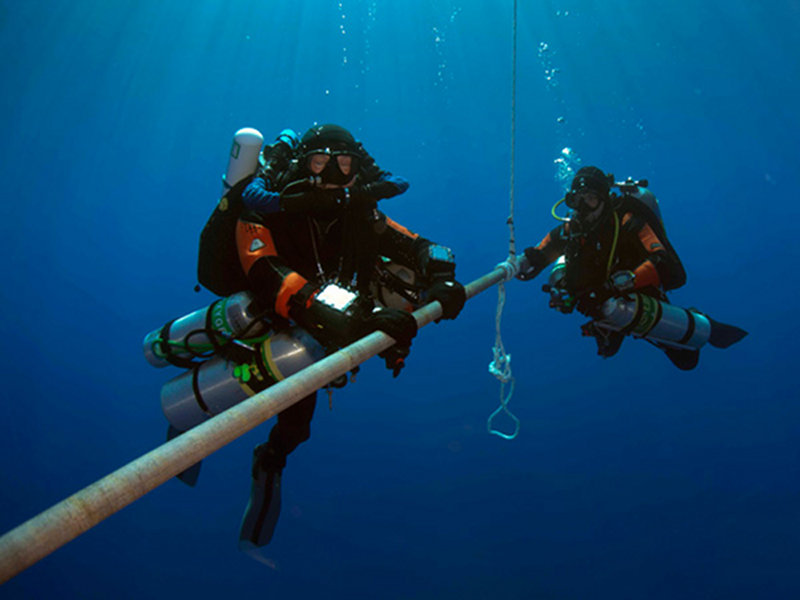
Tom and Brett on the deco bar at 20 foot depth. Brett watches over Tom and Jill while they perform their decompression obligation prior to surfacing. Image courtesy of Jill Heinerth, Bermuda Deep Water Caves 2011 Exploration, NOAA-OER. Download larger version (jpg, 1.6 MB).
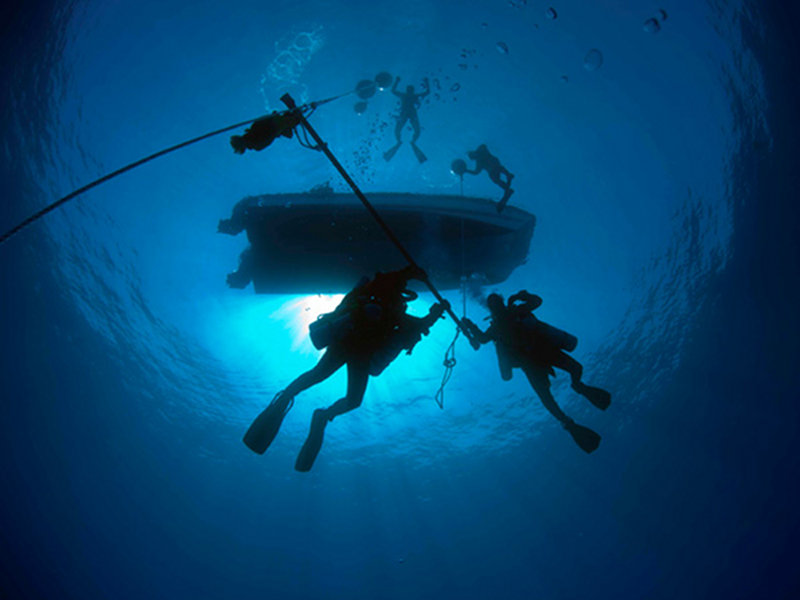
Silhouettes of the team at the deco bar and at the surface waiting for divers to return from the last dive. Image courtesy of Jill Heinerth, Bermuda Deep Water Caves 2011 Exploration, NOAA-OER. Download larger version (jpg, 2.3 MB).
As we worked our way upwards, Tom grabbed biological samples and sand from under the protective ledges, while I snapped photos of the transitioning life, trying to recall every detail to share with the scientists. Lace-like purple corals were only visible below 400 feet, but reddish, glowing soft corals only occurred above 250. Deep notches, likely carved by former Ice Age sea stands, were present around 365. Such details will have meaning to the many scientists who were reviewing our dives.
This dive represents the deepest manned exploration of Bermuda. ROVs, bathyspheres and subs have combed these depths before, but our first hand look will offer details never before available to scientists.
While Tom and I hung on the decompression line, a large manta ray graced the boat with its presence. Brian Kakuk stood watch on the vessel, while the rest of the support crew got a chance to swim and interact with the mighty creature. It was the perfect reward for a well executed project.
Support divers and crew rarely get the attention and thanks that they deserve. These dives would not be possible without a slew of volunteers. Brett Gonzalez has completed a dozen dives in the ocean and still has not seen the sea floor! Graham Maddox has captained our boat and lead the crew, yet only just got the first opportunity to free dive with a manta ray. So to all our support team: Graham Maddocks, Alex Chequer, Gil Nolan, Brett Gonzalez, Dr. Nicolas Alvarado, Ondrej Hindl, Marcus Cooper, Dr. David Wakeley, Sam Bennett, Dr. Pete Milan, Ken Vickers, Jeff Gardiner, Bobcat Mike, Mac and researchers Dr. Robbie Smith, Dr. Thad Murdoch and Steve Blasco as well as the entire staff at Triangle Diving, we thank you from the bottom of our hearts. You never stood down. You kept the complacency at bay and we all got home safe. That is the greatest achievement of all.